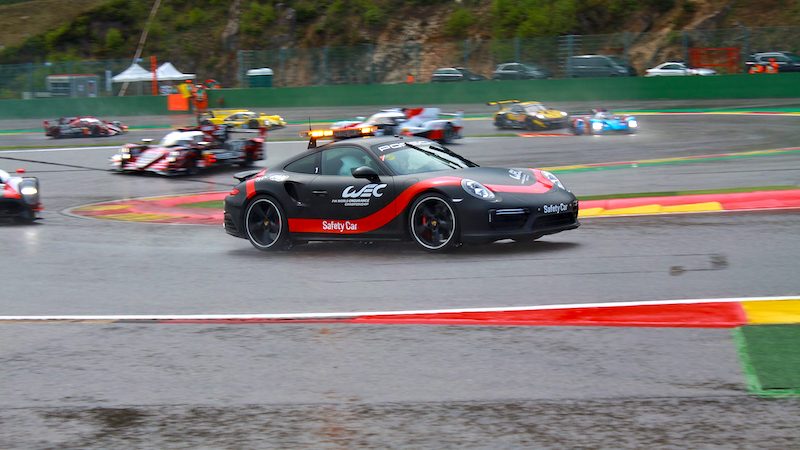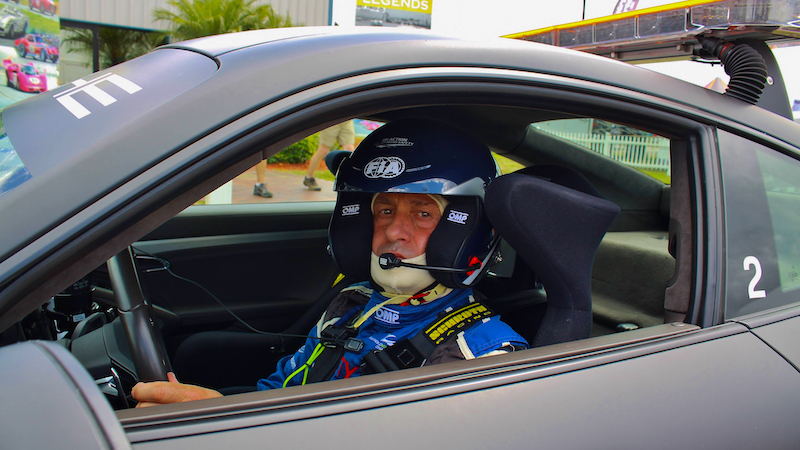The World Endurance Championship is more than just a racing series featuring impressive cars and talented drivers. Often a look behind the scenes can reveal what makes a championship tick on an international scale.
The safety car has become part and parcel of modern-day racing, joining the circuit to control cars’ pace if an on-track incident or bad weather makes conditions unsafe. From the 2018/2019 Super Season, Porsche have provided the official FIA WEC Safety Car in the form of a 911 Turbo.
Unlike the 911 RSR that competes in the GTE Pro and GTE Am classes, the Safety Car is largely the same as the road-going 911 Turbo. Only minor improvements have been made to the suspension and brakes for the car’s on-track activities.
From Le Mans to the Safety Car
French driver Yannick Dalmas has been the official Safety Car driver for the FIA WEC for a number of years now. His job is to keep track of everything when challenging situations arise and to keep race direction up to date on what’s going on.
For Dalmas, it’s not entirely simple to describe how exactly he came to drive the Safety Car around the world for the WEC and at Le Mans: “Everything began in motorsport,” he told WEC-Magazin in an exclusive interview. “Le Mans has always been an important race for me. I had the fortune to celebrate some of the best moments of my career here – and I stood atop the podium four times. My active motorsport career came to a natural end, and around seven years ago I became part of the WEC family.”
“When I first started, I acted as an intermediary between the stewards and race direction. I am responsible for the circuit inspection runs and often drove the race director around the track. That’s how I came to drive the Safety Car, not least because of my past motorsport experience. Now I do not drive for any particular team, I drive for all the other drivers.”
Dalmas believes that the most-significant difference between competitive motorsport and driving the Safety Car is the mindset: “If you have only ever raced cars on the track, you try and drive as quickly as possible with the best and most-aggressive lines. But driving the Safety Car is a completely different game. You learn to accept that you are no longer fighting for the lead even though you are at the front of the field. All eyes are on you, so you must treat your function as a role model seriously! That being said, it’s still probably one of the best jobs in motorsport.”

Intuition is key
Driving the Safety Car in difficult conditions – often during bad weather conditions – is no easy task. It takes a great deal of intuition and understanding to keep track of the whole field, as Dalmas explains: “Viewers at home will not always be able to see the differences in terms of speed behind the Safety Car. I always make sure I ask the drivers after the race what they thought of the Safety Car’s pace, but it is really hard to strike the right balance for all classes of cars.”
“The GTE drivers will tell you that the pace was spot on, whereas the LMP2 drivers often ask whether I could drive a little more quickly. The LMP1 drivers almost always say that it is difficult to stay behind the safety car as their cars are not really designed for such low speeds.”
“Each evolution in the regulations widens the gap between the classes. Probably the biggest change in the past 15 years has been the braking points in wet conditions. The biggest challenge for me in the Safety Car is to ensure that everyone on the circuit is safe.”
What the fans always wanted to know
We asked you, the community, if there was anything you ever wanted to ask the FIA WEC Safety Car driver, Yannick Dalmas. Here are some of the most-popular responses:
WM: Which Safety Car is better to drive, the Audi or the Porsche?
YD: Personally I would have to say that I prefer the Porsche to the Audi, as the Porsche has more in common with a racing car. It handles better in bad conditions, has more power to offer and also has special racing seats and sport modes, which the Audi didn’t have.
WM: What has been the most exciting moment so far in your role as Safety Car driver?
YD: Definitely two years ago in Le Mans. It started to rain severely in Free Practice and I was ask to go out on track to check out the conditions. I came under the Dunlop Bridge and accelerated down into the Forest Esses. There was a great deal of water on the circuit and suddenly the car began to aquaplane. I lost traction at the rear, but fortunately I was able to keep the car on track by drifting down the right-hander!
WM: Is there anything you would change about your job?
YD: I would love to get out on track more, such as in the break between the free practice sessions. Every kilometre on the circuit improves my understanding of the track and its particular characteristics. I would also like to have more information in the car. I have to sit in the car ready for action throughout the entire race, so for instance I’m not even able to go for a quick toilet break! A small screen with live timing or a TV feed would be great. I don’t really get to see what’s happening in the race and usually only find out what I need to know for my job.

